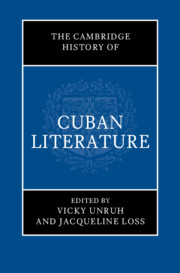Book contents
- The Cambridge History of Cuban Literature
- The Cambridge History of Cuban Literature
- Copyright page
- Dedication
- Contents
- Figures
- Contributors
- Acknowledgments
- Introduction Unfinished Histories
- Part I Literature in the Early Colony
- Part II Cuban Literature’s Long Nineteenth Century
- 3 Alexander von Humboldt and the Cultural Invention of Cuba Among Its Nineteenth-Century Intellectual Elite
- 4 Philosophy and Pedagogy in Félix Varela, José de la Luz y Caballero, and Enrique José Varona
- 5 Mercedes Merlin and the Rhetoric of Life Writing, Exile, and Race
- 6 The Lyric Vernacular of Cuban Romanticism
- 7 Gertrudis Gómez de Avellaneda as Literary Precursor and Transatlantic Intellectual
- 8 Racialized Futures
- 9 Journalism and Nineteenth-Century Literary Culture
- 10 José Martí as Hemispheric Visionary
- 11 Julián del Casal and the Other Faces of Cuban Modernismo
- 12 Performance Worlds of Nineteenth-Century Cuban Theater
- Part III Literary and Intellectual Culture in the Twentieth-Century Republic
- Part IV The Revolution’s Literary-Cultural Initiatives and Their Early Discontents
- Part V Cuba and Its Diasporas into the New Millennium
- Epilogue
- Select Bibliography
- Index
- References
3 - Alexander von Humboldt and the Cultural Invention of Cuba Among Its Nineteenth-Century Intellectual Elite
from Part II - Cuban Literature’s Long Nineteenth Century
Published online by Cambridge University Press: aN Invalid Date NaN
- The Cambridge History of Cuban Literature
- The Cambridge History of Cuban Literature
- Copyright page
- Dedication
- Contents
- Figures
- Contributors
- Acknowledgments
- Introduction Unfinished Histories
- Part I Literature in the Early Colony
- Part II Cuban Literature’s Long Nineteenth Century
- 3 Alexander von Humboldt and the Cultural Invention of Cuba Among Its Nineteenth-Century Intellectual Elite
- 4 Philosophy and Pedagogy in Félix Varela, José de la Luz y Caballero, and Enrique José Varona
- 5 Mercedes Merlin and the Rhetoric of Life Writing, Exile, and Race
- 6 The Lyric Vernacular of Cuban Romanticism
- 7 Gertrudis Gómez de Avellaneda as Literary Precursor and Transatlantic Intellectual
- 8 Racialized Futures
- 9 Journalism and Nineteenth-Century Literary Culture
- 10 José Martí as Hemispheric Visionary
- 11 Julián del Casal and the Other Faces of Cuban Modernismo
- 12 Performance Worlds of Nineteenth-Century Cuban Theater
- Part III Literary and Intellectual Culture in the Twentieth-Century Republic
- Part IV The Revolution’s Literary-Cultural Initiatives and Their Early Discontents
- Part V Cuba and Its Diasporas into the New Millennium
- Epilogue
- Select Bibliography
- Index
- References
Summary
Based on Political Essay on the Island of Cuba by Alexander von Humboldt, this chapter scrutinizes the interactive impact of his ideas about Cuba with those of the island’s criollo intellectual elite, in particular Francisco de Arango y Parreño and José de la Luz y Caballero, also noting the assessment of those collaborations by Vidal Morales y Morales and, in the twentieth century’s first half, by Fernando Ortiz. Central to the analysis is how these writers drew on Humboldt’s antislavery and scientific legacies, while silencing the essay’s predictive advocacy for an African confederation in the future free states of the Antilles. The chapter elucidates an abolitionist turn in Arango’s writing and the role of Luz’s extensive journeys to meet with such international figures as Humboldt for modernizing scientific research and education in Cuba. While noting a canonizing halo later surrounding Humboldt’s role in Cuba, the chapter reinforces his indispensability to imaginings of an antislavery, scientific, and even independentist Cuba.
Keywords
- Type
- Chapter
- Information
- The Cambridge History of Cuban Literature , pp. 67 - 81Publisher: Cambridge University PressPrint publication year: 2024



